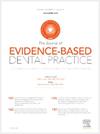DNA甲基化与口腔癌风险的关联:一项系统综述和荟萃分析
IF 4
4区 医学
Q1 DENTISTRY, ORAL SURGERY & MEDICINE
引用次数: 0
摘要
dna启动子甲基化是肿瘤抑制基因沉默的主要表观遗传机制之一。越来越多的科学证据表明,口腔癌(OC)中存在多种异常DNA甲基化基因,然而,DNA甲基化与OC风险之间的关联程度仍存在争议。目的评价DNA启动子甲基化对卵巢癌发生风险的总体和特异性影响。材料和方法检索spubmed、EMBASE、Web of Science和Cochrane Library,寻找符合条件的研究。采用纽卡斯尔-渥太华量表(NOS)评价纳入研究的方法学质量,采用病例对照设计。用R软件计算合并优势比(or)和95%置信区间(ci)来估计相关性的强度;用Egger检验来检测发表偏倚。结果共纳入41项研究,包括4218例OC患者和3478例非癌对照。总体而言,DNA启动子甲基化与OC风险之间存在显著关联(OR = 5.83,95% CI 4.14-8.20;P & lt;措施)。此外,合并的or显示特定肿瘤相关基因与OC风险之间存在显著关联:p16 (5.77;95% ci 3.95-8.45;P & lt;.001), ecad (4.47;95% ci 2.77-7.21;P & lt;.001), MGMT (3.85;95% ci 2.48-5.97;P & lt;.001), dapk (5.58;95% ci 2.14-14.56;P & lt;.001), hMLH1 (10.48;95% ci 1.04-106.1;P = .047),p14 (3.21;95% ci 1.78-5.78;P & lt;.001), p15 (5.02;95% ci 2.76-9.12;P & lt;措施)。结论基因启动子甲基化与卵巢癌风险存在显著的整体相关性。具体而言,p16、ECAD、MGMT、DAPK、hMLH1、p15和p14的启动子甲基化在口腔癌发生中发挥了重要作用,是预测OC和预后的有希望的生物标志物。本文章由计算机程序翻译,如有差异,请以英文原文为准。
ASSOCIATION OF DNA METHYLATION AND ORAL CANCER RISK: A SYSTEMATIC REVIEW AND META-ANALYSIS
Background
DNA promoter methylation is one of the main epigenetic mechanisms of silencing of tumor-suppressor genes in cancer. Accumulating scientific evidence has shown various genes with aberrant DNA methylation in oral cancer (OC), however, the magnitude of the association between DNA methylation and OC risk remains controversial.
Objective
To evaluate the overall and specific impact of DNA promoter methylation on the risk of OC development.
Material and methods
PubMed, EMBASE, Web of Science, and the Cochrane Library were searched for eligible studies. The Newcastle-Ottawa Scale (NOS) was used to evaluate the methodological quality of the included studies with a case-control design. The pooled odds ratios (ORs) and 95% confidence intervals (CIs) were calculated to estimate the strength of the associations with R software; and Egger’s test was used to detect publication bias.
Results
A total of 41 studies including 4218 OC patients and 3478 noncancer controls were included in the meta-analysis. Overall, a significant association was found between DNA promoter methylation and OC risk (OR = 5.83, 95% CI 4.14-8.20; P < .001). In addition, the pooled ORs showed a significant association between specific tumor-related genes and OC risk: p16 (5.77; 95% CI 3.95-8.45; P < .001), ECAD (4.47; 95% CI 2.77-7.21; P < .001), MGMT (3.85; 95% CI 2.48-5.97; P < .001), DAPK (5.58; 95% CI 2.14-14.56; P < .001), hMLH1 (10.48; 95% CI 1.04-106.1; P = .047), p14 (3.21; 95% CI 1.78-5.78; P < .001), and p15 (5.02; 95% CI 2.76-9.12; P < .001).
Conclusion
A significant overall association was found between gene promoter methylation and OC risk. Specifically, the promoter methylation of p16, ECAD, MGMT, DAPK, hMLH1, p15, and p14 displayed a significant role in oral carcinogenesis, acting as promising biomarkers for OC prediction and prognosis.
求助全文
通过发布文献求助,成功后即可免费获取论文全文。
去求助
来源期刊

Journal of Evidence-Based Dental Practice
DENTISTRY, ORAL SURGERY & MEDICINE-
CiteScore
6.00
自引率
16.70%
发文量
105
审稿时长
28 days
期刊介绍:
The Journal of Evidence-Based Dental Practice presents timely original articles, as well as reviews of articles on the results and outcomes of clinical procedures and treatment. The Journal advocates the use or rejection of a procedure based on solid, clinical evidence found in literature. The Journal''s dynamic operating principles are explicitness in process and objectives, publication of the highest-quality reviews and original articles, and an emphasis on objectivity.
 求助内容:
求助内容: 应助结果提醒方式:
应助结果提醒方式:


